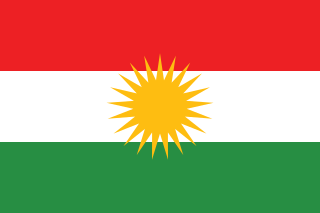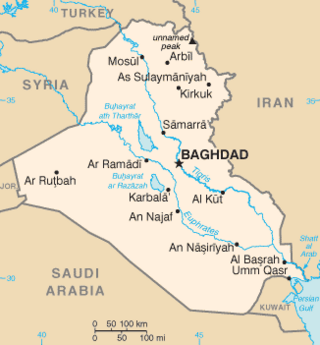
Iraqi Kurdistan or Southern Kurdistan refers to the Kurdish-populated part of northern Iraq. It is considered one of the four parts of "Kurdistan" in West Asia, which also includes parts of southeastern Turkey, northern Syria, and northwestern Iran. Much of the geographical and cultural region of Iraqi Kurdistan is part of the Kurdistan Region (KRI), an autonomous region recognized by the Constitution of Iraq. As with the rest of Kurdistan, and unlike most of the rest of Iraq, the region is inland and mountainous.

The Anfal campaign was a counterinsurgency operation which was carried out by Ba'athist Iraq from February to September 1988 during the Iraqi–Kurdish conflict at the end of the Iran–Iraq War. The campaign targeted rural Kurds because its purpose was to eliminate Kurdish rebel groups and Arabize strategic parts of the Kirkuk Governorate. The Iraqis committed atrocities on the local Kurdish population, mostly civilians.

The Peshmerga comprise the standing military of Kurdistan Region, an autonomous political entity within the Republic of Iraq. According to the Constitution of Iraq, the Peshmerga and their security subsidiaries are solely responsible for the security of Kurdistan Region, chiefly due to the fact that the Iraqi Armed Forces are forbidden to enter Iraqi Kurdistan. These subsidiaries include Asayish, Parastin û Zanyarî, and Zêrevanî. The Peshmerga's history dates back to the 18th century, when they began as a strictly tribal pseudo-military border guard under the Ottoman Turks and the Safavid Iranians. By the 19th century, they had evolved into a disciplined and well-trained guerrilla force.

Kurdistan Region is an autonomous administrative entity within the Republic of Iraq. It comprises four Kurdish-majority divisions of Arab-majority Iraq: the Erbil Governorate, the Sulaymaniyah Governorate, the Duhok Governorate, and Halabja Governorate. The KRI is bordered by Iran to the east, by Turkey to the north, and by Syria to the west. It does not govern all of Iraqi Kurdistan, and lays claim to the disputed territories of northern Iraq; these territories have a predominantly non-Arab population and were subject to the Ba'athist Arabization campaigns throughout the late 20th century. Though the KRI's autonomy was realized in 1992, one year after Iraq's defeat in the Gulf War, these northern territories remain contested between the Kurdistan Regional Government and the Government of Iraq to the present day. In light of the dispute, the KRI's constitution declares the city of Kirkuk as the capital of Iraqi Kurdistan. However, the KRI does not control Kirkuk, and the Kurdistan Region Parliament is based in Erbil. In 2014, when the Syria-based Islamic State began their Northern Iraq offensive and invaded the country, the Iraqi Armed Forces retreated from most of the disputed territories. The KRI's Peshmerga then entered and took control of them for the duration of the War in Iraq (2013–2017). In October 2017, following the defeat of the Islamic State, the Iraqi Armed Forces attacked the Peshmerga and reasserted control over the disputed territories.

The 1991 Iraqi uprisings were ethnic and religious uprisings against Saddam Hussein's regime in Iraq that were led by Shi'ites and Kurds. The uprisings lasted from March to April 1991 after a ceasefire following the end of the Gulf War. The mostly uncoordinated insurgency was fueled by the perception that Iraqi President Saddam Hussein had become vulnerable to regime change. This perception of weakness was largely the result of the outcome of the Iran–Iraq War and the Gulf War, both of which occurred within a single decade and devastated the population and economy of Iraq.

Operation Zafar 7 was an Iranian offensive during the Iran–Iraq War. The Iranian military operation was successfully led by Lieutenant General Hossein Hassani Sa'di where Iran won the battle and also repelled the ensuing Iraqi Counterattack. However, Iran faced technical setbacks with massive economic and military sanctions in place against the country. As a result of those setbacks, Iran was unable to reach its objective of capturing Sulaymaniyah.

The Iraqi Kurdish Civil War was a civil war that took place between rival Kurdish factions in Iraqi Kurdistan during the mid-1990s, mostly between the Patriotic Union of Kurdistan and the Kurdistan Democratic Party. Over the course of the conflict, Kurdish factions from Iran and Turkey, as well as Iranian, Iraqi and Turkish forces, were drawn into the fighting, with additional involvement from American forces. Between 35,000 and 40,000 fighters and civilians were killed.

Kosrat Rasul Ali is a Kurdish politician and the leader of the Supreme Political Council of Patriotic Union of Kurdistan (PUK), veteran Peshmerga military leader, former Prime Minister, and former Vice President of the Kurdistan Region.

The Kurdistan Democratic Party, usually abbreviated as KDP or PDK, is the largest party in Iraqi Kurdistan and the senior partner in the Kurdistan Regional Government. It was founded in 1946 in Mahabad in Iranian Kurdistan. The party states that it combines "democratic values and social justice to form a system whereby everyone in Kurdistan can live on an equal basis with great emphasis given to rights of individuals and freedom of expression."

Nawshirwan Mustafa was an Iraqi Kurdish politician who served as the General Coordinator of the Movement for Change and the leader of the opposition in the Kurdistan Region from 1 April 2009 to his death on 19 May 2017.

The 1983–1986 Kurdish rebellions in Iraq occurred during the Iran–Iraq War as PUK and KDP Kurdish militias of Iraqi Kurdistan rebelled against Saddam Hussein as part of the Iraqi–Kurdish conflict, in an attempt to form an independent state. With Iraqi government forces occupied by the Iran-Iraq War, Kurdish Peshmerga succeeded in taking control of some enclaves, with Iranian logistic and sometimes military support. The initial rebellion resulted in stalemate by 1985.
The Second Iraqi–Kurdish War was the second chapter of the Barzani rebellion, initiated by the collapse of the Kurdish autonomy talks and the consequent Iraqi offensive against rebel KDP troops of Mustafa Barzani during 1974–1975. The war came in the aftermath of the First Iraqi–Kurdish War (1961–1970), as the 1970 peace plan for Kurdish autonomy had failed to be implemented by 1974. Unlike the previous guerrilla campaign in 1961–1970, waged by Barzani, the 1974 war was a Kurdish attempt at symmetric warfare against the Iraqi Army, which eventually led to the quick collapse of the Kurds, who were lacking advanced and heavy weaponry. The war ended with the exile of the Iraqi KDP party and between 7,000–20,000 deaths from both sides combined.

The Iraqi–Kurdish conflict consists of a series of wars, rebellions and disputes by the Kurds against the central authority of Iraq starting in the 20th century shortly after the defeat of the Ottoman Empire in World War I. Some put the marking point of the conflict beginning to the attempt by Mahmud Barzanji to establish an independent Kingdom of Kurdistan, while others relate to the conflict as only the post-1961 insurrection by the Barzanis. Since the US-led invasion of Iraq and the subsequent adoption of federalism and the recognition of the Kurdistan Region (KRI) as a federal entity in the new Iraqi constitution, the number and scope of armed clashes between the central government of Iraq and the Kurds have significantly decreased. In spite of that, however, there are still outstanding issues that continue to cause strife such as the disputed territories of northern Iraq and rights to export oil and gas, leading to occasional disputes and armed clashes. In September 2023, following a series of punitive measures by the central government in Iraq against KRI, Masrour Barzani sent a letter to the President of the United States expressing concerns about a possible collapse of the Kurdistan Region, and calling for the United States to intervene.

The 1979 Kurdish rebellion in Iran was one of the largest nationwide uprisings in the country against the new state following the Iranian Revolution. The Kurdish rebellion began in mid-March, just two months after the Revolution ended, and was one of the most intense Kurdish rebellions in modern Iran.
The National Defense Battalions were Iraqi Kurdish paramilitary units that initially emerged from a pro-government Kurdish militia raised by the regime of Abdul-Karim Qasim used against Kurdish insurgents during the First Iraqi–Kurdish War. The Battalions were used quite prominently during the Iran-Iraq War, particularly during the Anfal Campaign. Many of the Battalions' units rebelled in the 1991 uprusing and joined the Peshmerga, although the Battalions survived, albeit in a reduced capacity, until the Ba'athist government was toppled in 2003.
The Peshmerga have historically been Kurdish guerrilla forces combating the ruling power in the region of what is now Iraqi Kurdistan. Under Mahmud Barzanji, the Peshmerga fought against the British Empire after World War I. They also spearheaded revolts against the Iraqi government in 1931–1932 and against Iran in 1946–1947. Under the leadership of Mustafa Barzani, Peshmerga forces fought the Iraqi government in the First and Second Iraqi–Kurdish Wars of the 1960s and 1970s, and supported Iran in the Iran–Iraq War of the 1980s. The Peshmerga became divided between forces loyal to the Kurdistan Democratic Party (KDP) and those loyal to the Patriotic Union of Kurdistan (PUK), a split that led to the Iraqi Kurdish Civil War of 1995–1998. After the 2003 invasion of Iraq, the Peshmerga became the official military forces of the Kurdistan Region, ruled by a KDP-PUK coalition. The Peshmerga have played an important role in re-taking territory occupied by Islamic State of Iraq and the Levant.

The Battle of Kirkuk (2017), part of the 2017 Iraqi–Kurdish conflict, was a military deployment by the Iraqi Security Forces to retake Kirkuk Governorate from the Peshmerga after the latter ignored repeated warnings to withdraw, sparking clashes between the two forces. The advance began on 15 October 2017, with the city of Kirkuk being retaken the following day. Iraqi central government forces continued their advances in subsequent days, routing the Peshmerga forces across vast swathes of territory in northern Iraq.

The 2017 Iraqi–Kurdish conflict, also known as the Kirkuk crisis, was a conflict in which the Iraqi government retook disputed territories in Iraq which had been held by the Peshmerga since ISIL's Northern Iraq offensive in 2014. The conflict began on 15 October 2017 after tensions arising from the Kurdistan Region independence referendum of 25 September. The tension between the federal Iraqi government and Kurdistan Region escalated into conflict when the Peshmerga ignored repeated warnings to return Kirkuk to Iraqi government forces. Part of the conflict was the Battle of Kirkuk, when Iraqi forces routed Peshmerga forces from the city in a surprise dawn-offensive, marking the beginning of clashes.

The 1st Corps was a corps of the Iraqi Army, established before the Iran–Iraq War. It was located in Kurdistan Region.
The Kurdistan Region–PKK conflict is a series of battles and clashes in Iraqi Kurdistan between the ruling Kurdistan Regional Government against the Kurdistan Workers' Party (PKK) and its allied groups. It started in 1983 and is still ongoing in the form of an insurgency. The PKK's primary method is using guerrilla warfare against the Peshmerga.















